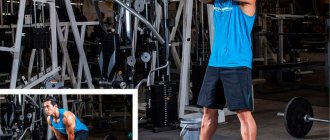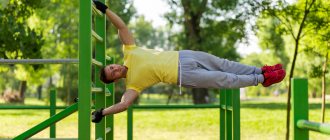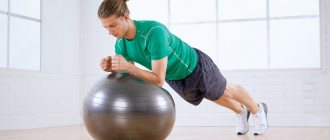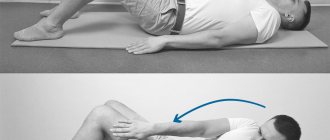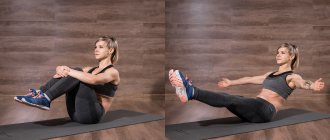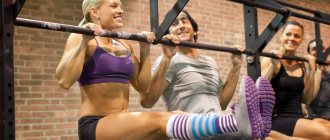The most popular and best-selling exercise machine for use in home workouts can be considered an abdominal bench. This is due, first of all, to the misconception about creating attractive abs in the abdominal area, which, as many believe, appears due to intensive work on the abdominal muscles. Of course, everything is not so simple with these, for many, unattainable cubes. In fact, an ab bench is a multifunctional sports equipment that allows you to perform various exercises at home.
Do you need a press bench at home?
Such fitness equipment as a press bench is not essential sports equipment, but its presence will allow you to perform various exercises with greater comfort and technically correct.
If we talk only about abdominal training, then a bench is not necessary for these exercises. In home training, the abdominal muscles can be well worked out without using any equipment, for example, by performing straight crunches and leg lifts. All these exercises are performed without the use of sports equipment while lying on the floor.
It’s another thing to do other exercises at home without having any sports equipment. For example, pullovers, flyes, dumbbell or barbell presses become a big problem, because you will have to adapt household utensils for them. As a result, the exercise will either be performed technically incorrectly, which will make the training ineffective, or even make the exercises hazardous.
It may not be possible to build a convenient and reliable structure, in our case a bench. An abdominal bench will allow you to include exercises for different muscle groups into the training process with minimal equipment. The athlete also gains control over movements, exercises become safer, and the training itself becomes much more effective and comfortable.
How to pump up abs for a man
Men, first of all, need to focus on the size of the rectus muscle - perform exercises with weights in the range of 8-15 repetitions. Do not neglect the safety belt in basic movements, but also do not wear it where it is not needed, because... he will simply “steal” the load from the press.
Exercises:
We recommend reading: Exercises for the sternum muscles for men at home
- Crunches on a 4x10 block;
- Hanging leg raises (with weights) 3x10;
- Crunches with 4x8 top block;
- Burpee 4x20;
- Pull-ups “Corner” 4x10.
What types of press benches are there?
There are not many types of benches for the press, but they all have their own characteristics.
- The most popular are adjustable abdominal benches with a variable backrest angle. Such models allow you to perform various exercises, work your abs and back from different angles, thereby changing the load and emphasis on different muscle areas.
- Another option that is very popular is benches with a reverse backrest angle . They are suitable for more advanced athletes. Their disadvantage is the inability to perform many exercises.
- The next type of benches for the press are models with a folding design . They are suitable for use in small residential spaces. The disadvantage of this equipment is its relatively weak design.
- Benches with a curved back - these models are designed for athletes who have problems in the lower spine (lower back). Due to the bending, their functionality is less.
- Adjustable abdominal benches.
- Bench with a reverse backrest angle.
- Folding bench.
- Benches with a curved back.
Anatomy of exercise - which muscles work
Target working muscle and auxiliary muscles:
- Rectus abdominis muscle
- Quadriceps, obliques, tensor fasciae lata, iliopsoas
Benefits of the exercise:
- Suitable for beginners;
- Allows you to progress and increase the load;
- Not dangerous;
- Has many modifications and options
Flaws
Those who go to an inexpensive gym will have to suffer for quite a long time if their shins are slightly larger than those of the average person. It is not convenient to train on an incline bench for those who have large hamstrings. Such people cannot always adjust a cheap small shop to suit themselves. More professional equipment takes into account the anthropometric characteristics of professional athletes. The second disadvantage is the inability to adequately perform the movement at home. They sell universal benches for the home, but they are only convenient for working out your abs, and not for performing other exercises as well.
The best bench exercises for abs
There are a lot of exercises that can be performed on the abdominal bench. Their number depends on the design of the bench. Some of the models allow you to perform hyperextension.
Here is a short list of exercises that can be performed on most ab benches.
Crunches
- Take a lying position with your legs between the fixing rollers.
- The movement towards the knees is carried out by contracting the abdominal muscles.
- The back should be rounded throughout the entire amplitude.
- Your hands can be pressed to your chest or behind your head.
- The exercise can also be performed with additional weights (with a dumbbell, weighted disk, ball).
- The upward movement is performed while exhaling.
- You can also perform oblique twists by adding a rotation of the body in the middle of the amplitude (alternately).
Read more about incline crunches →
Leg Raise
- Take a position on the bench so that your pelvis is on the edge of the bench and your head is near the fixing rollers.
- Hold onto the bolsters or edges of the bench with your hands.
- In the starting position, the legs should be vertical.
- Due to the tension of the abdominal muscles, the lower back should be pressed against the bench.
- Lower your legs as you inhale until they are parallel to the floor.
- Perform the return movement while exhaling.
- To simplify the technique, the exercise can be performed at half amplitude or lower the legs alternately.
Dumbbell Bench Press
The exercise can be performed at various angles, but we will consider the horizontal press option.
- The bench must be set in a horizontal position.
- Lying on a bench, rest your feet on the floor or fix them on bolsters.
- Place dumbbells at your shoulder joints. Elbows should point down.
- Exhale and push the dumbbells up, straightening your elbows.
- As you inhale, return to the starting position.
- When pressing, try to keep your chest open and your shoulders back.
You can use a barbell for this exercise, however, you will need additional equipment (racks) or a partner to do this.
You can also perform dumbbell flyes while lying down for the pectoral muscles.
Stepping onto a bench
The exercise is aimed at working the muscles of the legs and buttocks. It can be performed without additional weights.
- Stand facing the bench. Take a step with your foot on the bench.
- Push your body weight with your heel as you exhale, straighten your knee and rise onto the bench, placing your other leg.
- Then, in reverse order, lower your feet to the floor while inhaling.
- The movement on each leg should be alternated.
- The exercise can be performed with weights. Dumbbells or leg weights are a great option for an added challenge.
Reverse push-ups
The exercise is aimed at working the triceps and pectoral muscles without additional weights.
- You need to turn your back to the bench, place your palms under your shoulders on the edge of the bench, and your torso closer to the edge of the bench.
- Your legs should be straightened in front of you, resting on your heels.
- As you inhale, bend your elbows to a right angle, lowering your pelvis lower to the floor.
- As you exhale, straighten your elbows fully using the strength of your triceps.
To simplify the technique, your knees can be bent. A more difficult option is to use weights (a barbell or a weighted disk) or an additional elevation for the legs.
Read more about push-ups →
The bench allows you to perform push-ups (classic) on a hill, in which your hands are placed on the bench, as well as placing your feet at the top and doing push-ups from the floor, performing an exercise with a negative incline.
Main conclusions
You can train your abs in different ways. The bench allows you to add the necessary variety by changing the angle of the load, and there are many exercises that can be performed on this apparatus, which will also increase variety and help you incorporate new methods into the process.
When performing abdominal exercises, including on a bench, straight and inclined, you need to take into account general recommendations for training, nutrition and regimen. Otherwise, the classes will not bring the desired result, no matter what methods are chosen.
Recommendations for training
- When using an ab bench, do not ignore the warm-up.
- Having a bench for the press does not necessarily use it to work out the abdominal muscles; train other muscle groups with the help of the bench. The training complex should include exercises for the legs, back, chest and deltoids.
- If you exercise without weights, perform exercises in the range of 20-30 repetitions for 3-4 sets. Such training on the press bench will be aimed at improving the aesthetics of the muscles.
- If the training is aimed at increasing muscle volume, then the presence of additional equipment is mandatory, and the number of repetitions is reduced to 10-12, even in the “twisting” exercise.
How to work on a bench
The press can be pumped in different ways. There are no strict rules, so everyone can choose exercises from a huge list. In this case, it is better to be guided by your own feelings and feedback: in one case, twisting is more effective, in another - leg raises, in the third you should pay attention to working on the bench.
In any case, you should not focus on just movements; the program should change regularly in order to “shock” the muscles with a new type of load. In this regard, working on a bench has undoubted advantages. You can perform many different abdominal exercises on it, both straight and incline.
Bench exercises have a number of benefits, including:
- a straight and hard bench allows you to properly fix your back properly;
- There are a lot of exercises on the bench, which will diversify the training process;
- using a special bench will allow you to properly fix your legs;
- You can perform movements with full and short amplitude, which also diversifies your training.
Important! The main feature of working on a bench is the use of a “holder” for the legs. This clamp will hold the body, allow you to focus the load on the abdominal muscles, and avoid jerking.
Be sure to watch: Making a slim waist and tightening your abs: exercises and tips A set of exercises for the abs and legs: a set of workouts for muscles, buttocks, thighs Details on how to properly pump up your abs to remove belly fat How to pump up your oblique abdominal muscles: basic exercises
Roman chair crunches
You can do abdominal crunches on a Roman chair. This exercise pumps up almost all the abdominal muscles. Only with the help of it alone can you achieve the appearance of a beautiful relief on the press. The key to success in this case is to do body lifts correctly and regularly. The technique for performing twists is as follows:
You can pump up your abs on a Roman chair in other ways. There is a type of exercise called oblique crunches. In this case, lifting the body should not be done straight, but with a deviation to the side. In this case, one hand should be placed behind the head, and the other should rest on the thigh. When lifting the body, you need to touch the opposite leg with the elbow of the hand that is located behind the head.
There are also reverse crunches. In this case, you need to perform not lifting the torso, but lifting the legs and pelvis. In this case, the head should be located on the Roman chair where the legs should have been. In this case, you should grasp the soft rollers with your hands. As you exhale, you need to raise your legs and pelvis. When you inhale, you should return them back.
Contraindications
This exercise is not recommended for any injuries of the hip joints and femoral neck. Back and lower back problems should also be addressed before the client discovers the incline bench. Even simple discomfort in the lower back means that it is better to switch to a fitball, or lying down;
Hypertensive patients should not make the bench angle too high. A significant angle of inclination promotes a rush of blood to the head and can lead to pressure changes;
A bench with a high rise is not recommended for those who have myopia and a tendency to retinal detachment. Such a person should not actively perform exercises in which the head is lower than the chest. Moreover, you should not “strain” when pumping up your abs. It is better to do hanging leg raises with this condition;
The exercise can also be quite unsafe for spinal hernias. If there is no deterioration, the choice of exercises should be discussed with your doctor.

